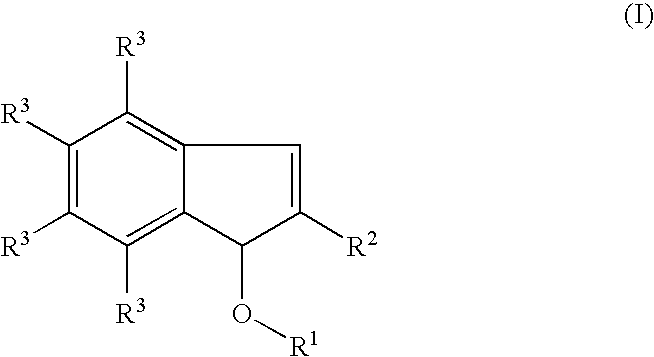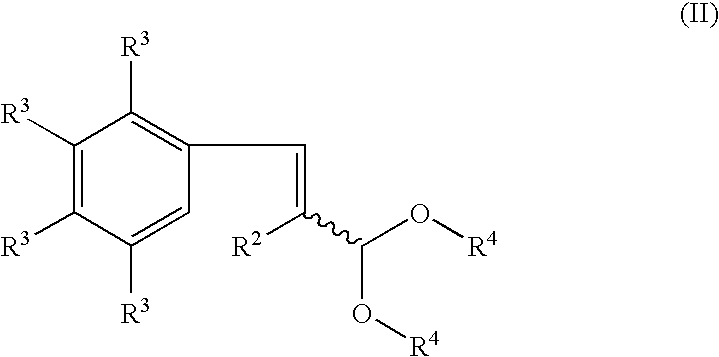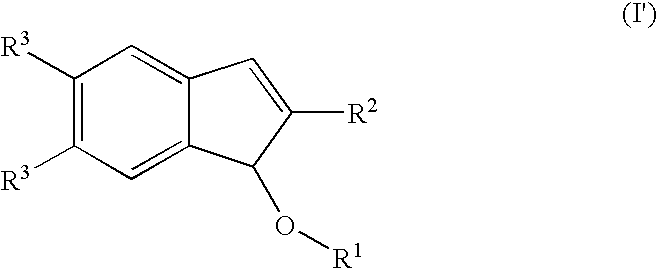Process for producing indenol esters or ethers
a technology of indenol esters and ethers, which is applied in the field of process for making indenol ester or ethers from a cinnamic aldehyde substituted derivative, can solve the problems of long and/or expensive methods of preparation of said compounds reported in the prior ar
- Summary
- Abstract
- Description
- Claims
- Application Information
AI Technical Summary
Benefits of technology
Problems solved by technology
Method used
Image
Examples
example 1
Cyclisation of 2-alkylcinnamic Aldehyde via the Acylal Derivative
a) Preparation of 2-pentyl-1H-inden-1-yl Acetate
[0048]4.13 ml of a 0.25 M solution of FeCl3.6H2O in Ac2O (1.03 mmol) where diluted into Ac2O (30.2 g) and the resulting solution was added dropwise during 1 hour to a stirred solution of 2-pentylcinnamaldehyde (20 g, 99 mmol) in AcOH (18.5 g) at reflux.
[0049]After a further 2 hours at reflux the cooled mixture was poured into a mixture of H2O and Et2O. Then, solid Na2CO3 (44.7 g) was added portionwise to the stirred mixture. After one hour stirring the aqueous phase was saturated with NaCl and extracted with Et2O. The organic layers were dried over anhydrous Na2SO4, and the solvent evaporated to afford a crude product, which was further purified by distillation under vacuum to give the desired compound (yield=87%).
[0050]B.p. 86-93° / 0.05 mbar. 1H-NMR: 0.90 (br.t, J=7, 3H); 1.35 (4H); 1.58 (m, 2H); 2.17 (s, 3H); 2.29 (m, 2H); 6.21 (s, 1H); 6.43 (s, 1H); 7.09 (dd, J=7, J=7, ...
example 2
a) Preparation of 1-methoxy-2-methyl-1H-indene via Cyclisation of the Acetal
[0055]A solution of FeCl3 anhydrous (42 mg, 0.25 mmol) in BuOAc (4 ml) was added dropwise during 10 minutes to a stirred solution of the 3,3-dimethoxy-2-methyl-1-phenyl-1-propene (5 g, 24.7 mmol) in BuOAc (13 ml) at 123° C. After 3 hours the cooled mixture was diluted with Et2O (50 ml) and washed with saturated aqueous NaHCO3 and brine. Extraction, drying over anhydrous Na2SO4, concentration and fractional distillation under vacuum gave a crude product that was further purified by chromatography (SiO2, cyclohexane / AcOEt 95:5 then AcOEt / Et2O 1:1). There was thus obtained the title compound with a yield of 33%.
[0056]B.p. 32-43° / 0.07 mbar. 1H-NMR: 2.03 (s, 3H); 3.03 (s, 3H); 4.85 (s,1H); 6.44 (s, 1H); 7.09 (dd, J=7, J=7, 1H); 7.11 (d, J=7, 1H); 7,22 (m, 1H); 7.41 (d, J=7, 1H). 13C-NMR: 145.9 (s); 143.9 (s); 141.8 (s); 128.7 (d); 128.4 (d); 124.6 (d); 123.7 (d); 120.1 (d); 84.9 (d); 51.8 (q); 14.1 (q).
b) Prepara...
example 3
Synthesis of 2,6-dimethyl-1H-inden-1-yl Acetate from the Corresponding Aldehyde
[0058]A solution of (2E)-2-methyl-3-(4-methylphenyl)-2-propenal (100.0 g, 0.62 mol) in cyclohexane (300.0 g) was added dropwise in 2 hours to a stirred solution of zinc chloride (3.1 g, 22 mmol) in acetic anhydride (188.4 g, 1.85 mol) at 80° C. The reaction mixture was stirred further at 80° C. for 18 hours and then cooled to 25° C. The mixture was washed twice with water (100.0 g) and a 5% aqueous solution of sodium carbonate (100.0 g) and concentrated under reduced pressure. The crude product was flash-distilled (B.p.: 75-90° C. / 0.1 mbar) affording 88.5 g of the desired acetate (69%) as a yellow liquid (purity: 97.1% GC).
[0059]1H-NMR: 7.19 (s, 1H); 7.03 (d, J=7.9, 1H); 6.99 (d, J=7.9, 1H); 6.37 (s, 1H); 6.11 (s, 1H); 2.31 (s, 3H); 2.17 (s, 3H); 1.95 (s, 3H). 13C-NMR: 171.5 (s); 143.3 (s); 142.3 (s); 141.0 (s); 134.8 (s); 129.2 (d); 125.2 (d); 120.0 (d); 78.4 (d); 21.3 (q); 21.1 (q); 14.0 (q).
PUM
| Property | Measurement | Unit |
|---|---|---|
| temperature | aaaaa | aaaaa |
| temperature | aaaaa | aaaaa |
| temperature | aaaaa | aaaaa |
Abstract
Description
Claims
Application Information
 Login to View More
Login to View More - R&D
- Intellectual Property
- Life Sciences
- Materials
- Tech Scout
- Unparalleled Data Quality
- Higher Quality Content
- 60% Fewer Hallucinations
Browse by: Latest US Patents, China's latest patents, Technical Efficacy Thesaurus, Application Domain, Technology Topic, Popular Technical Reports.
© 2025 PatSnap. All rights reserved.Legal|Privacy policy|Modern Slavery Act Transparency Statement|Sitemap|About US| Contact US: help@patsnap.com



